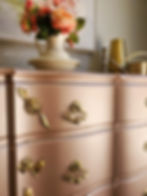The Difference Between Furniture Wax and Glaze
- Sep 13, 2020
- 3 min read
How do you answer the question, “Which product is more appropriate for my furniture painting project, wax, or a glaze? There are a few factors that I keep in mind when deciding which finish I want to use. Let’s explore the similarities and differences between furniture wax and glaze.
* This post may contain affiliate links. If you purchase I could make a commission at no charge to you. Please read my disclosure and my privacy policy here.
Materials Mentioned:

Glaze added around mouldings to create definition
Don’t Miss Out!
Sign up to have all Brandy’s projects emailed to you.
Join my email list
Processing…
Success! You're on the list.
Whoops! There was an error and we couldn't process your subscription. Please reload the page and try again.
Glaze Furniture Finish:
I often use glaze applied over paint to create an aged or grungy effect. Glaze is a liquid formula, water-based, and comes in a variety of colors. Because chalk Paint and glaze are both water-based, you are able to custom tint the glaze with a bit of paint. It is important to remember that furniture glaze is not a protective coat.
A few features of glaze, and ways I like to use it on my furniture painting projects are:
Apply over clear coat for more control and ability to wipe back
Apply over raw paint for a more grungey look
Usually applied with a brush, dug into crevices, and wiped back
Can be used for detail work or over an entire piece
Add a topcoat over glaze to seal it in place
How I Have Used Glaze On Painted Furniture:

Glaze with the Wood Graining Tool for faux barn wood finish.

Black Glaze for dimension with gold leaf

Black Glaze over Sea Spray texture


Black Glaze for contrast against white paint

Van Duke Brown Glaze for crisp details

Sapphire Pearl Glaze for an over all shimmer

Glaze overall for an aged farmhouse look

Wax Furniture Finish:
The furniture wax I use is a paste-like. Most brands are oil-based, some of which have liquid wax formulas. Wax does act as a protective layer for furniture paint and can be buffed to a beautiful low sheen.
A few features of wax, and ways I like to use it on my painting projects are:
Apply over raw paint to deepen your paint color
Apply over clear coat to easily wipe back
Can be applied with a brush or rag
Can be used for detail work or over the entire piece
No topcoat required over wax, it will cure and become its own layer of protection
Comes in a variety of colors, usually black, white, brown, gray.
Here Are A Some Examples Of How I Have Used Wax Finish On Painted Furniture:

Black Wax on mauve for dramatic edges

See what a difference Black Wax and Gold Gilding Wax add to these doors?

Black Wax for dimension around details

White Wax to soften paint colors and gather in crevices

Black Wax against white for smudgy corners

White Wax on black paint for a softened look

Clear Wax with Artisan Powders for authentic dusty dirt

Wax adds to a shading effect

Black Wax overall to deepen a paint color
I generally prefer glaze for fine details and wax for a more smudgy effect. Because glaze is a liquid, it does a great job of finding low points and settling in to create depth and dimension with a more concentrated look than waxes.
These products can both do double duty, often interchangeable and up to personal preference. For me, I’m 100% a wax girl. I use black wax on just about every project I do, and there is nothing like the smooth, ethereal, blending only a wax can give!
You can see glaze and wax in action in this video where I add finishing touches a headboard.
Use one or combine them together for the benefits of both. I hope these images will help see the differences between furniture glaze and wax, and the unique looks both can give.






